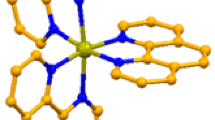Abstract
The cross-polarization magic angle carbon-13 nmr spectra of a series of bis(xanthato) complexes of mercury(II) are reported; [Hg(S2COR)2] n R=Me, Et,nPr andiPr. The spectra correlate well with the known crystal structures of theR=Me, Et, andiPr compounds and with that of theR=nPr derivative for which a single-crystal X-ray diffraction study is also reported. The X-ray analysis of [Hg(S2COnPr)2] n shows that this compound adopts a two-dimensional structure comprised of connected 16-membered rings which arise as a result of bridgingn-propylxanthate ligands. The mercury atom lies on a crystallographic twofold axis of symmetry and exists in a distorted tetrahedral geometry with two unique Hg-S bond distances of 2.418(3) and 2.835(4) Å. Unit-cell dimensions for [Hg(S2COnPr)2] n are:a=7.371(3),b=8.534(4),c=11.618(4) A andZ=2 for the orthorhombic space groupP21212. The structure was refined by a full-matrix least-squares procedure to finalR=0.047 andR w =0.044 for 899 reflections withI≥2.5σ(I). While the solid state nmr spectra provide information on molecular (and crystallographic) symmetry they do not provide sufficient detail to enable structure determination for the [Hg(S2COR)2] compounds.
Similar content being viewed by others
References
Bondi, A. (1964)J. Phys. Chem. 68, 441.
Chieh, C., and Moynihan, K. J. (1980)Acta Crystallogr. B 36, 1367.
Dixon, W. T. (1981)J. Magn. Reson. 44, 220.
Hamilton, W. C., and Ibers, J. A. (1974) Editors,International Tables forX-Ray Crystallography (Kynoch Press, Birmingham, England), Vol. IV, pp. 99, 149.
Hounslow, A. M, Lincoln, S. F., and Tiekink, E. R. T. (1989)J. Chem. Soc., Dalton Trans. 233.
Johnson, C. K. (1971)OrtepII. Report ORNL-3794 (Oak Ridge National Laboratory, Tenn.).
Sheldrick, G. M. (1976)Shelx76.Program for Crystal Structure Determination (Univ. of Cambridge, England).
Tiekink, E. R. T. (1987)Acta Crystallogr. C 43, 448.
Watanabe, Y. (1977)Acta Crystallogr. B 33, 3566.
Watanabe, Y. (1981)Acta Crystallogr. B 37, 553.
Author information
Authors and Affiliations
Rights and permissions
About this article
Cite this article
Hounslow, A.M., Tiekink, E.R.T. Correlations between nuclear magnetic resonance spectra and crystal structure. III. A13C nuclear magnetic resonance study in the solid state of bis(xanthato) complexes of mercury(II); The crystal and molecular structure of bis(n-propyl-dithiocarbonato)mercury(II). Journal of Crystallographic and Spectroscopic Research 21, 133–137 (1991). https://doi.org/10.1007/BF01161054
Received:
Issue Date:
DOI: https://doi.org/10.1007/BF01161054




